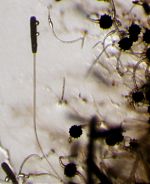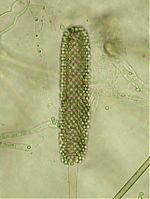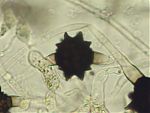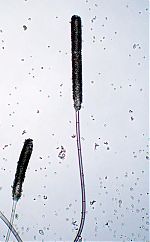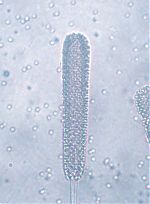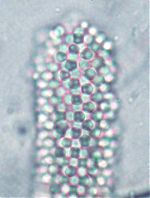Mycotypha
MYCOTYPHA Fenner, 1932 (Mycologia 24:196); 3 spp. (Benny et al., 1985—monograph).
Species of Mycotypha produce cylindrical vesicles at the apex of sporangiophores that usually are initially simple but that can become branched in age. The vesicle bears two distinct types of denticles: 1) one that is short and that bears a globose, unispored sporangium, and 2) a longer one that give rise to an obovoid or cylindrical unispored sporangium. Zygospores, where known, are formed between opposed suspensors, and an ornamented and pigmented zygosporangium is produced (Benny et al. 1985).
Type species: M. microspora
Species of Mycotypha:
M. africana Novak & Backus, 1963 (Mycologia 55:793).
M. indica P.M. Kirk & Benny, 1985 (in Benny, P.M. Kirk, and Samson, Mycotaxon 22:131).
M. microspora Fenner, 1932 (Mycologia 24:196).
Mycotypha spp. have been isolated from dung and soil. Species of Mycotypha have been collected in Finland, India, Japan, U.S.A. (Arizona, California, District of Columbia, Iowa, Kansas), and Zimbabwe (Mikawa, 1975, 1979; Benny and Benjamin, 1976; Benny et al., 1985).
All species form yeast cells when grown on nutrient-rich media such as MEYE. Mycotypha species have been illustrated by Young (1969), Benny and Benjamin (1976), Brain and Young (1979), Benny et al., 1985), Ginman and Young (1991), and Edelmann and Klomparens (1995). Mycotypha africana and M. microspora do not form a columella in their unispored sporangia (Khan and Talbot, 1975; Brain and Young, 1979) based on ultrathin sections of these structures.
Bibliography
Benny, G.L., and R.K. Benjamin. 1976. Observations on Thamnidiaceae (Mucorales). II. Chaetocladium, Cokeromyces, Mycotypha, and Phascolomyces. Aliso 8:391-424.
Benny, G.L., P. M. Kirk, and R. A. Samson. 1985. Observations on Thamnidiaceae (Mucorales). III. Mycotyphaceae fam. nov. and a re-evaluation of Mycotypha sensu Benny & Benjamin illustrated by two new species. Mycotaxon 22:119-148.
Brain, A.P.R., and T.W.K. Young. 1979. Ultrastructure of the asexual apparatus in Mycotypha. Microbios 25:93-106.
Edelmann, R.E., and K.L. Klomparens. 1995. Low temperature scanning electron microscopy of the ultrastructural development of zygospores and sporangiospores in Mycotypha africana, and the effects of cultural conditions on sexual versus asexual reproduction. Mycol. Res. 99:539-548.
Ginman, A.T., and T.W.K. Young. 1991. SEM of sporangiospores and Y-phase cells in Mycotypha africana. The Mycologist 5(2):71-72.
Khan, S.R., and P.H.B. Talbot.1975. Monosporous sporangiola in Mycotypha and Cunninghamella. Trans. Brit. Mycol. Soc. 65:29-39.
Mikawa, T. 1975. Materials for the fungus flora of Japan (18). Trans. Mycol. Soc. Japan 16:146-148.
Mikawa, T. 1979a. A taxonomic study on Japanese sporangiferous Mucorales (2). J. Japan. Bot. 54:5-14.
Young, T.W.K. 1969. Electron and phase-contrast microscopy of spores in two species of the genus Mycotypha (Mucorales). J. Gen. Microbiol. 55:243-249.
Updated Dec 03, 2008

